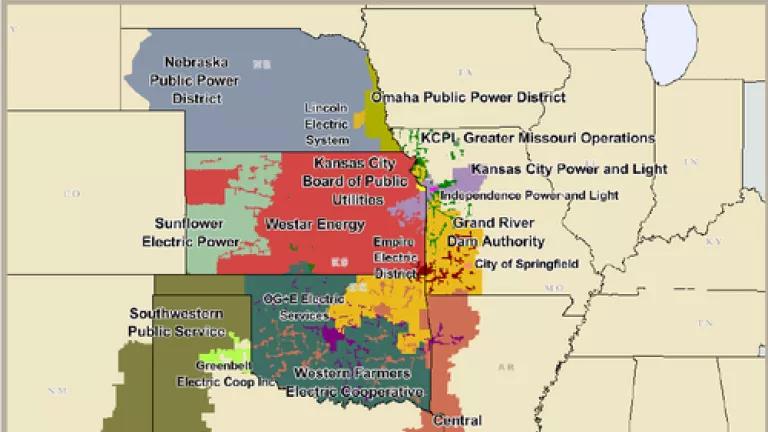
This post was updated following the public release of the study.
The Environmental Protection Agency’s proposed Clean Power Plan for existing power plants will cut carbon pollution and save thousands of lives a year while strengthening our power grid and keeping electricity affordable. After the standards are finalized next June, states will have up to three years to develop plans to implement them. They’ll examine many different available strategies to generate enough power to meet our nation’s needs while assuring the service reliability Americans expect and count on. But some players – notably the Great Plains region’s transmission grid operator – are jumping the gun with premature warnings of dire consequences for the grid.
The Southwest Power Pool (SPP), the regional operator of the high power electric grid in the Great Plains, has just released a study on how the Clean Power Plan might affect its grid. It has some serious shortcomings, and SPP should correct them as it moves forward with additional analysis. Among them is a gaping hole: SPP didn’t take into account the building of any new power plants or other measures like efficiency (apart from some plants already on the drawing board), that likely would result from state implementation of the Clean Power Plan.
SPP’s approach is a little like a home remodeler who tears out the weight-bearing walls without building any new supports, and then wonders why the building buckles. Here’s how SPP got it wrong, why its study may cause more confusion than clarity, and a better approach.
(Source: FERC)
Grid planning 101
Think of SPP’s transmission lines as the highways across which electricity from wind, coal, and other power plants travel to consumers. As the regional grid operator for most of Nebraska, Kansas, Oklahoma, and parts of several surrounding states, SPP is responsible for the planning and operation of the power grid in that region. Consumers, utilities, and states in SPP have entrusted the organization to manage the electric grid to provide reliable power and affordable power across the region.
Among SPP’s responsibilities is considering grid needs triggered by new environmental laws like the Clean Power Plan. Once the parameters of the Clean Power plan are finalized in 2015, states in the SPP region will be responsible for developing compliance plans to meet the carbon pollution standards. States can use a mix of energy efficiency, existing and new renewable energy, and other power plants to meet the new standards, which as proposed require only modest reductions in carbon pollution. SPP, in turn, will look at what upgraded and new transmission lines and other grid improvements might be necessary to help the states achieve their plans. This kind of planning is routine; it is SPP’s job to look at system impacts, guide states when appropriate to help them make the best choices, and design the grid accordingly.
Problems with SPP’s approach
SPP's most glaring error: it assumed the closure of thousands of megawatts of coal plants by 2020 but none of the replacement power resources which would occur during CPP implementation. To quote from its report, "due to time constraints [SPP] did not evaluate the viability or reliability impacts of any of the building blocks used to establish those proposed goals." (page 2). Those missing "building blocks" include new wind and solar, natural gas and energy efficiency that states will add to their energy mix to meet those standards, plus any other state and regional compliance solutions. Not surprisingly, with that critical missing piece and some unrealistic assumptions baked into its study, SPP found Big Reliability Problems.
Another problem: at this point it’s unclear whether the plants EPA “retired” in its own model actually will close. One plant that SPP assumed will close – the Sooner Plant in Oklahoma – is slated to get $500 million in new pollution control equipment, so closing the plant is anything but a sure bet.
Other problems in the study include:
- Timetable errors: SPP’s study assumes an inflexible final compliance deadline of 2020, even though the interim target allows averaging over the years 2020-2029, giving states substantial flexibility that SPP ignores.
- Renewables ignored: SPP didn’t add any new wind, solar, natural gas, or other generation solutions states might choose alone or together as a region to meet the standards. SPP did add some new wind and natural gas power but these plants are already in the development stage, and SPP assumed very low levels of new wind power.
- Efficiency ignored: SPP didn’t consider whether any new energy efficiency, energy storage, demand response or other similar customer-controlled solutions would make up part of states’ compliance plans – even though these resources often cost half the price of new generation.
A better way
Transmission system planning normally considers all of the pieces of the puzzle:
- new power plants,
- state and federal clean energy rules,
- expected future energy demand and economic changes,
- efficiency improvements, and
- transmission projects needed to deliver power to consumers.
SPP’s attempt to consider the Clean Plan misses most of these pieces: no new transmission projects, power plants, or energy efficiency resources beyond those already on the drawing board. Instead, SPP seems to be saying that the Clean Power Plan is too much, too soon, based mainly on one piece of the puzzle – losing some coal plants which may or may not retire.
SPP’s study also says nothing about the reasonableness of the standards or the many options for compliance (including whether regional approaches are cheaper than the states acting alone). SPP should seize the opportunity to help the states and others to understand all options and facilitate the affordable, effective implementation of the Clean Power Plan. SPP alone has the staff, data, and computational power to help its states and utilities develop the best possible plans to meet the new standards, and then to determine whether any grid changes are necessary.

